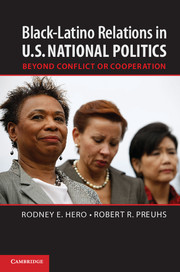64 results
Unequal values: equality and race in state of the union addresses, 1960–2018
-
- Journal:
- Journal of Race, Ethnicity and Politics / Volume 6 / Issue 3 / November 2021
- Published online by Cambridge University Press:
- 28 October 2021, pp. 499-528
-
- Article
- Export citation
American Politics and Political Science in an Era of Growing Racial Diversity and Economic Disparity
-
- Journal:
- Perspectives on Politics / Volume 14 / Issue 1 / March 2016
- Published online by Cambridge University Press:
- 21 March 2016, pp. 7-20
- Print publication:
- March 2016
-
- Article
- Export citation
Outsiders No More? Models of Immigrant Political Incorporation. Edited by Jennifer Hochschild, Jacqueline Chattopadhyay, Claudine Gay, and Michael Jones-Correa. New York: Oxford University Press, 2013. 305p. $99.00 cloth, $39.95 paper.
-
- Journal:
- Perspectives on Politics / Volume 12 / Issue 4 / December 2014
- Published online by Cambridge University Press:
- 22 December 2014, pp. 916-917
- Print publication:
- December 2014
-
- Article
- Export citation
Contents
-
- Book:
- Black–Latino Relations in U.S. National Politics
- Published online:
- 05 February 2013
- Print publication:
- 21 January 2013, pp vii-vii
-
- Chapter
- Export citation
Acknowledgments
-
- Book:
- Black–Latino Relations in U.S. National Politics
- Published online:
- 05 February 2013
- Print publication:
- 21 January 2013, pp xv-xvi
-
- Chapter
- Export citation
3 - Black-Latino Relations in Congressional Testimony and the Legal Arena
-
- Book:
- Black–Latino Relations in U.S. National Politics
- Published online:
- 05 February 2013
- Print publication:
- 21 January 2013, pp 55-98
-
- Chapter
- Export citation
5 - Black-Latino Relations in the U.S. House of Representatives
-
- Book:
- Black–Latino Relations in U.S. National Politics
- Published online:
- 05 February 2013
- Print publication:
- 21 January 2013, pp 114-147
-
- Chapter
- Export citation
6 - The Role of Group Interests and Ideology in Cross-Group Support
-
- Book:
- Black–Latino Relations in U.S. National Politics
- Published online:
- 05 February 2013
- Print publication:
- 21 January 2013, pp 148-180
-
- Chapter
- Export citation
2 - What Previous Research Tells Us about Black-Latino Relations
-
- Book:
- Black–Latino Relations in U.S. National Politics
- Published online:
- 05 February 2013
- Print publication:
- 21 January 2013, pp 28-54
-
- Chapter
- Export citation
1 - Introduction
-
- Book:
- Black–Latino Relations in U.S. National Politics
- Published online:
- 05 February 2013
- Print publication:
- 21 January 2013, pp 1-27
-
- Chapter
- Export citation
Preface
-
- Book:
- Black–Latino Relations in U.S. National Politics
- Published online:
- 05 February 2013
- Print publication:
- 21 January 2013, pp xi-xiv
-
- Chapter
- Export citation
4 - Salience and Congruence in Policy Positions
-
- Book:
- Black–Latino Relations in U.S. National Politics
- Published online:
- 05 February 2013
- Print publication:
- 21 January 2013, pp 99-113
-
- Chapter
- Export citation

Black–Latino Relations in U.S. National Politics
- Beyond Conflict or Cooperation
-
- Published online:
- 05 February 2013
- Print publication:
- 21 January 2013
Index
-
- Book:
- Black–Latino Relations in U.S. National Politics
- Published online:
- 05 February 2013
- Print publication:
- 21 January 2013, pp 243-252
-
- Chapter
- Export citation
List of Tables and Figures
-
- Book:
- Black–Latino Relations in U.S. National Politics
- Published online:
- 05 February 2013
- Print publication:
- 21 January 2013, pp viii-x
-
- Chapter
- Export citation
Abbreviations
-
- Book:
- Black–Latino Relations in U.S. National Politics
- Published online:
- 05 February 2013
- Print publication:
- 21 January 2013, pp xvii-xviii
-
- Chapter
- Export citation
8 - Conclusions
-
- Book:
- Black–Latino Relations in U.S. National Politics
- Published online:
- 05 February 2013
- Print publication:
- 21 January 2013, pp 214-230
-
- Chapter
- Export citation
Frontmatter
-
- Book:
- Black–Latino Relations in U.S. National Politics
- Published online:
- 05 February 2013
- Print publication:
- 21 January 2013, pp i-vi
-
- Chapter
- Export citation
7 - Further Explorations of Black-Latino Relations and Policies in National Politics
-
- Book:
- Black–Latino Relations in U.S. National Politics
- Published online:
- 05 February 2013
- Print publication:
- 21 January 2013, pp 181-213
-
- Chapter
- Export citation
Bibliography
-
- Book:
- Black–Latino Relations in U.S. National Politics
- Published online:
- 05 February 2013
- Print publication:
- 21 January 2013, pp 231-242
-
- Chapter
- Export citation

